The United States Postal Service's Railway Mail Service was a significant mail transportation service in the US from the mid-19th century until the mid-20th century. The RMS, or its successor the Postal Transportation Service (PTS), carried the vast majority of letters and packages mailed in the United States from the 1890s until the 1960s.

A steamship, often referred to as a steamer, is a type of steam-powered vessel, typically ocean-faring and seaworthy, that is propelled by one or more steam engines that typically move (turn) propellers or paddlewheels. The first steamships came into practical usage during the early 1800s; however, there were exceptions that came before. Steamships usually use the prefix designations of "PS" for paddle steamer or "SS" for screw steamer. As paddle steamers became less common, "SS" is assumed by many to stand for "steam ship". Ships powered by internal combustion engines use a prefix such as "MV" for motor vessel, so it is not correct to use "SS" for most modern vessels.

Postal history is the study of postal systems and how they operate and, or, the study of the use of postage stamps and covers and associated postal artifacts illustrating historical episodes in the development of postal systems. The term is attributed to Robson Lowe, a professional philatelist, stamp dealer and stamp auctioneer, who made the first organised study of the subject in the 1930s and described philatelists as "students of science", but postal historians as "students of humanity". More precisely, philatelists describe postal history as the study of rates, routes, markings, and means.

An ocean liner is a passenger ship primarily used as a form of transportation across seas or oceans. Liners may also carry cargo or mail, and may sometimes be used for other purposes.
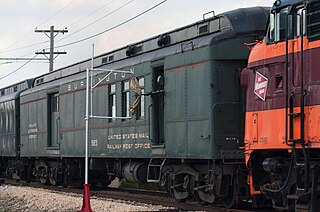
In the United States, a railway post office, commonly abbreviated as RPO, was a railroad car that was normally operated in passenger service as a means to sort mail en route, in order to speed delivery. The RPO was staffed by highly trained Railway Mail Service postal clerks, and was off-limits to the passengers on the train. In the UK and Ireland, the equivalent term was Travelling Post Office (TPO).

A Travelling Post Office (TPO) was a type of mail train used in Great Britain and Ireland where the post was sorted en route. The last Travelling Post Office services were ended on 9 January 2004, with the carriages used now sold for scrap or to preservation societies.

CP Ships was a large Canadian shipping company established in the 19th century. From the late 1880s until after World War II, the company was Canada's largest operator of Atlantic and Pacific steamships. Many immigrants travelled on CP ships from Europe to Canada. The sinking of the steamship RMS Empress of Ireland just before World War I was the largest maritime disaster in Canadian history. The company provided Canadian Merchant Navy vessels in World Wars I and II. Twelve vessels were lost due to enemy action in World War II including the largest ship sunk by a German U-boat, RMS Empress of Britain.
The Railway Mail Service (RMS) Library is a major collection of materials pertaining to en route distribution history. Incorporated in May 2003, it can assist researchers interested in Railway Mail Service, route agent, Seapost, Railway Post Office (RPO), and Highway Post Office (HPO) history. The collection has many unique, original-source documents that provide answers to questions dealing with the transportation and distribution of USA Mail between 1862 and 1977, as well as other countries during the 19th century and 20th century.
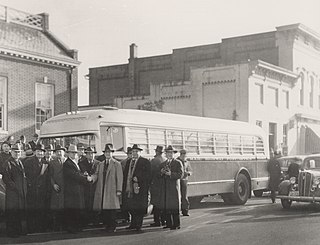
The term Highway Post Office refers to brightly colored red, white and blue buses used to carry mail to multiple areas over wide distances.
An Air Mail Facility is an installation for Airmails of the United States.
Terminal railway post offices were sorting facilities which were established by the Railway Mail Service to speed the distribution of parcel post. These offices were usually located in or near railroad stations in major cities or junction points. Terminal railway post offices operated generally from 1913-1914 into the mid-1960s, before their function was absorbed by post office sectional centers.

From the 1880s until well into the 1950s, virtually all long-distance transportation of United States Mail was performed by the railroads. Specially equipped Railway Post Office (RPO) cars were a part of most passenger trains, the cars staffed by highly trained railway postal clerks who sorted mail as the train sped along its route. The growth of this mail distribution network paralleled the expansion of the railroads, allowing mail to be exchanged between routes at junction points where two railroads crossed or shared passenger terminals.
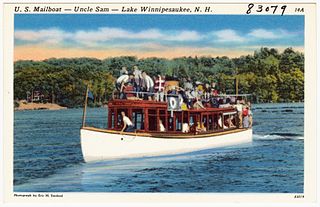
Post was transported over water in the United States in the later nineteenth and the twentieth century.
The Postal Transportation Service (PTS) was the renamed successor to the Railway Mail Service of the United States Post Office Department from 1 October 1949. Although this branch of the service had been in charge of all transit mail, some parts had little to do with railroads, even though they were still the most important part of the service. In 1950, of the 32,000 clerks assigned to the PTS, only about 16,000 actually worked on trains. The remainder were in terminals, transfer offices, Air Mail Facility, Highway Post Offices (HPO), administrative offices, etc. Boat Railway Post Office, Streetcar Railway Post Offices, and the Seapost Service had already been discontinued. The name of the Chief Clerk's office was changed to District Superintendent's office.
Streetcar Railway Post Office (RPO) routes operated in several major USA cities between the 1890s and 1920s. The final route was in Baltimore, Maryland. The Mobile Post Office Society, Affiliate 64 of the American Philatelic Society, has published monographs detailing the operational history of each route.
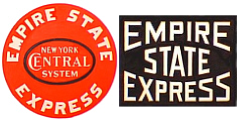
The Empire State Express was one of the named passenger trains and onetime flagship of the New York Central and Hudson River Railroad. On September 14, 1891 it covered the 436 miles (702 kilometers) between New York City and Buffalo in 7 hours and 6 minutes, averaging 61.4 miles-per-hour (98.8 km/h), with a top speed of 82 mph (132 km/h).

Mobile post offices deliver mail and other postal services through specially equipped vehicles, such as trucks and trains.

RMS Empress of China was an ocean liner built in 1890-1891 by Naval Construction & Armament Co., Barrow, England for Canadian Pacific Steamships (CP). This ship—the first of three CP vessels to be named Empress of China—regularly traversed the trans-Pacific route between the west coast of Canada and the Far East until she struck an underwater reef and sank in Tokyo harbour in 1911.
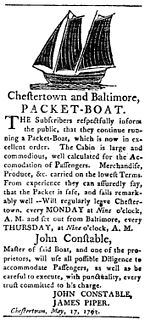
Packet boats were medium-sized boats designed for domestic mail, passenger, and freight transportation in European countries and in North American rivers and canals, some of them steam driven. They were used extensively during the 18th and 19th centuries and featured regularly scheduled service.

A Travelling Post Office (TPO) is a postal receiving, sorting and delivery service situated on a train, usually in a specially designated carriage that is part of a passenger train. In Queensland, Australia, the service was provided from 1877 to 1932.













